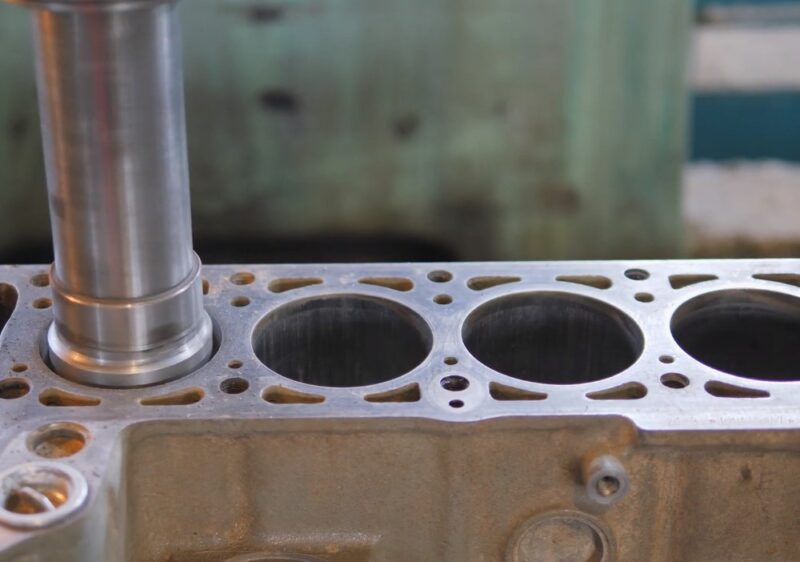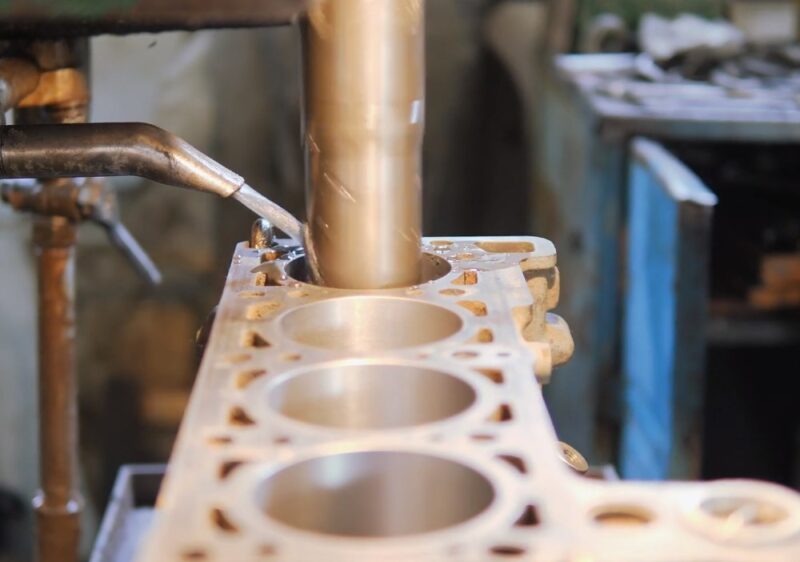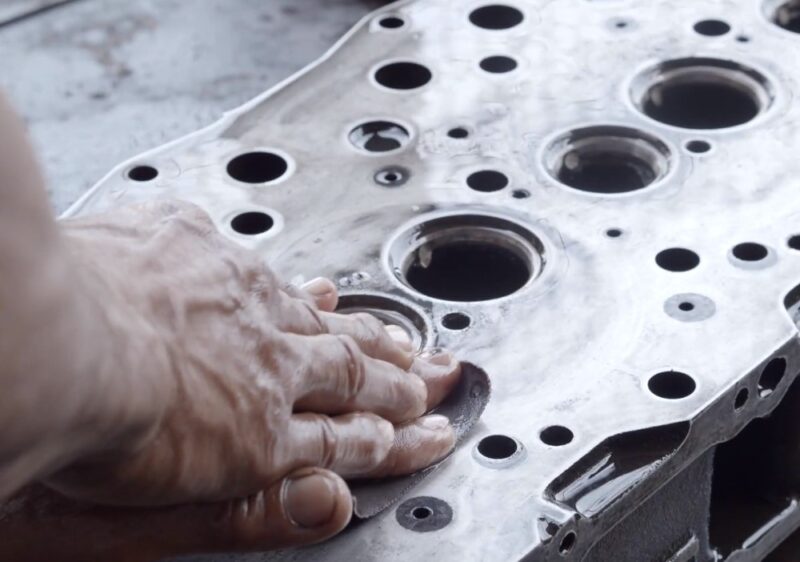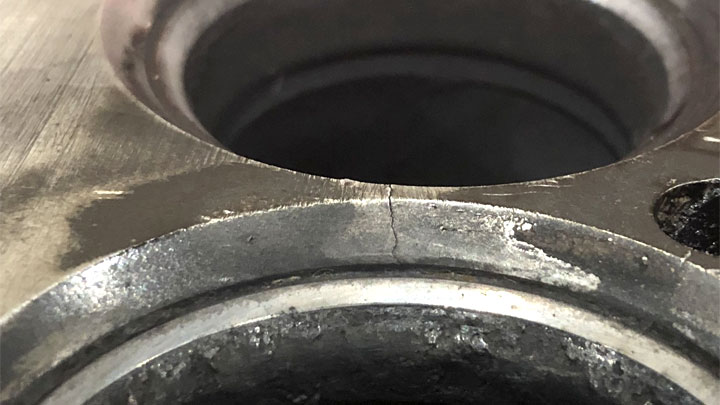The cylinder head is a pivotal component in an internal combustion engine. Often abbreviated to just “head”, it sits above the cylinders and forms the roof of the combustion chamber. In simpler engines, like sidevalve engines, the head is a mere sheet of metal.
However, in modern overhead valve and overhead camshaft engines, it’s a complex block containing various passages for inlet and exhaust, coolant, and houses components like valves, camshafts, spark plugs, and fuel injectors. Understanding its importance is crucial, as it plays a significant role in the combustion process.
This article aims to show you the signs, symptoms, and replacement costs of a cracked cylinder head.
Fun Fact: Most straight engines have a single cylinder head shared by all of the cylinders, while most V engines have two, one for each bank of cylinders.
The Cylinder Head

More than just a cap for the engine’s cylinders. It’s an integral part of the combustion process. By forming the roof of the combustion chamber, it ensures that the fuel-air mixture is compressed adequately before ignition.
Its location, right above the cylinders, makes it a hotspot for thermal activity. In modern engines, especially the overhead valve and overhead camshaft types, the cylinder head is a maze of passages. These passages allow for the intake of fresh air and fuel and the exhaust of burnt gases.
Additionally, in water-cooled engines, the cylinder head contains passages for the engine’s coolant fluid, ensuring that the head remains at an optimal temperature.
Pro Tip: Regularly checking the cylinder head for signs of wear or damage can prevent costly repairs in the future.
Causes of Cracks
- Thermal Stress and Heat Cycles: The constant heating and cooling of the engine can cause the metal of the cylinder head to expand and contract. Over time, this can lead to cracks.
- Coolant Leaks and Overheating: If the engine’s cooling system isn’t functioning correctly, it can cause the engine to overheat, putting additional stress on the cylinder head.
- Poor Maintenance and Neglect: Not changing the engine oil or coolant regularly or using the wrong type can lead to increased wear and tear.
- Manufacturing Defects: Sometimes, the material or the manufacturing process itself might be flawed, leading to weak points in the cylinder head.
Signs and Symptoms
A cracked cylinder head can manifest in various ways, often mimicking the symptoms of a blown head gasket. Here are some common signs to watch out for:
- White Smoke (Steam) From the Exhaust Pipe: If you notice white smoke, which is essentially steam, billowing from your exhaust, it could be due to coolant leaking into the combustion chamber through cracks.
- Low Coolant Level: A crack might allow coolant to seep into the combustion chamber, leading to a noticeable drop in the coolant level.
- Engine Overheating: If the coolant is entering the combustion chamber instead of circulating through the engine, the engine might overheat.
- Rough Running and Misfiring: A loss of compression due to a crack can cause the engine to run roughly and misfire.
- Combustion Gases In the Cooling System: Combustion gases might find their way into the cooling system due to a crack, leading to excessive bubbles in the coolant.
- Illuminated Warning Lights: Your dashboard might light up with the check engine light, low coolant level light, or the engine over-temperature light.
- Coolant-Oil Intermix: In some cases, a crack can cause the coolant and oil to mix, leading to a milky substance in the oil reservoir.
Pro Tip: Always get your cylinder heads checked for cracks by a machine shop when doing a head gasket job. They have specialized tools to detect cracks not visible to the naked eye.
Diagnostic Process
To confirm a cracked cylinder head, a series of tests and inspections are necessary:
- Visual Inspection: Start by visually inspecting for any visible cracks or signs of damage.
- Compression and Leak-Down Tests: These tests can help determine if there’s a loss of compression in any of the cylinders, which might indicate a crack in the head.
- Coolant Pressure Test: This test can help identify if there’s a leak in the cooling system, which might be due to a crack.
- Oil Analysis: Analyzing the oil can reveal if there’s any coolant present, indicating a possible crack.
Fun Fact: Some cylinder heads can develop cracks due to design flaws. However, the most common cause is engine overheating due to thermal stress.
Importance of Timely Repair

Driving with a cracked cylinder head is akin to walking on thin ice. The potential consequences are severe:
- Engine Damage: The longer you drive with a crack, the more damage you risk inflicting on your engine. This can lead to costly repairs or even a complete engine replacement.
- Decreased Performance: A crack can lead to reduced engine performance, making your vehicle sluggish and less responsive.
- Safety Concerns: Overheating can lead to engine fires, putting you and your passengers at risk.
- Environmental Impact: Leaking coolant and increased emissions due to a crack can harm the environment.
Pro Tip: Addressing a cracked cylinder head promptly can save you from more extensive and expensive repairs down the line.
Replacement Cost
The financial sting of addressing a cracked cylinder head can vary significantly based on several factors:
- Vehicle Make and Model: Different cars come with different price tags for parts. A luxury vehicle’s cylinder head will likely cost more than that of an economy car.
- Labor Rates: Depending on where you live and the mechanic you choose, labor rates can fluctuate. Some regions or specialized mechanics might charge more.
- New vs. Used: Opting for a used or refurbished can save you money, but it might not offer the same longevity or warranty as a new part.
- Additional Repairs: If the crack has led to other issues, such as mixed coolant and oil, those systems will need to be addressed, adding to the cost.
On average, replacing can set you back anywhere from $750 to $4,250 per head. This range is broad because it accounts for the various factors mentioned above. It’s also worth noting that while older vehicles might have had the option to repair, modern cars, especially those with aluminum heads, usually require a replacement.
Pro Tip: Always get a few quotes from different mechanics or service centers. This will give you a better understanding of the potential costs and help you make an informed decision.
DIY vs. Professional Repair

Tackling a cylinder head replacement isn’t for the faint of heart. Here’s a quick comparison:
DIY Approach
- Pros: Potential cost savings on labor.
- Cons: Requires advanced mechanical knowledge, specialized tools, risk of making errors, and no professional warranty on the work.
Professional Repair:
- Pros: Expertise ensures the job is done correctly, access to specialized tools and equipment, and often comes with a service warranty.
- Cons: Labor costs can be high, especially at dealerships or specialized service centers.
Fun Fact: Today’s cylinder heads are primarily made from aluminum, making them lighter but also more susceptible to damage compared to the older iron ones.
FAQ
What causes a cylinder head to crack?
The primary culprit is engine overheating due to a malfunctioning cooling system. Design flaws in certain engines can also lead to cracks.
Can a cracked cylinder head be repaired?
While older vehicles with iron might have had the option for repair, modern vehicles, especially those with aluminum, typically require a replacement.
How long can I drive with a cracked cylinder head?
It’s not advisable to drive with a crack. The longer you do, the more damage you risk inflicting on your engine.
Conclusion
The cylinder head is a cornerstone of your vehicle’s engine, playing a pivotal role in the combustion process. When it cracks, the repercussions can be severe, affecting not only the engine’s performance but also its longevity.
Recognizing the signs early and addressing them promptly can save you from more extensive damages and hefty repair bills. Whether you’re a seasoned car enthusiast or a daily commuter, understanding the importance of the cylinder head and the potential risks of cracks is essential.
Always prioritize your vehicle’s health and safety, and when in doubt, consult with a professional.

